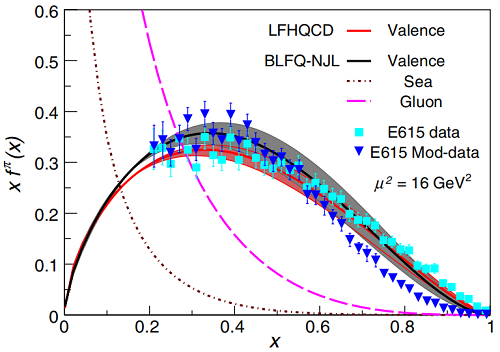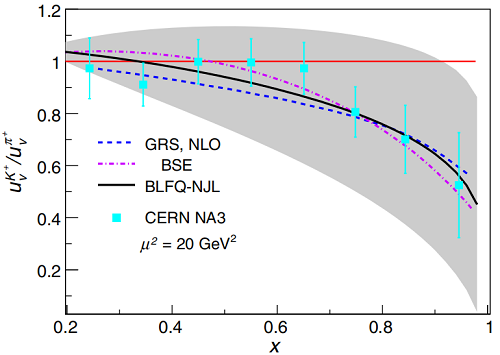Highly Relativistic Bound Systems Described by a Novel Theoretical Approach
Pions and kaons, the two lightest mesons, have long been postulated as a combination of a valence quark-antiquark pair strongly bound by the strong nuclear force mediated by gluons. The systems are so tiny and tight-bound that these constituents are moving near the speed of light. Understanding the structure of the pions and the kaons in terms of “valence” wave functions, the probability amplitude of the valence quark and antiquark pair with respect to its kinematics, is now available through the theoretical framework of Basis Light-Front Quantization (BLFQ), which combines relativistic Hamiltonian dynamics with many-body methods previously applied to the calculation of non-relativistic bound states. With these valence wave functions for pions and kaons determined, their structures experimentally observed by high-resolution probes are now understood after taking into account the theoretically well-founded splitting of the valence quarks and antiquarks into gluons along with additional quark-antiquark pairs.
The researchers obtain the pion and the kaon parton distribution functions (PDFs) from the overlap of the eigenstates of an effective confining and chiral Hamiltonian in the valence quark-antiquark representation suitable for low-momentum scale applications. After QCD evolution, the PDF of the pion is shown in Fig.1 which describes the probability of finding a parton (quark, gluon) carrying a (longitudinal) momentum fraction x of the pion momentum. The ratio of the up quark PDF of the kaon to that of the pion is shown in Fig. 2. We observe that our results are consistent with the experimental data as well as with other phenomenological models. It may constitute a breakthrough in the understanding of the light meson quark content.
This work has been done in collaboration between Institute of Modern Physics (IMP) in China, and Iowa State University in USA. Mr. Jiangshan Lan, a master student of IMP, is the leading author of this work. Dr. Chandan Mondal and Prof. Xingbo Zhao are the other co-authors from IMP whereas Dr. Shaoyang Jia and Prof. James P.Vary are the co-authors from Iowa State University.
The work is supported by the National Natural Science Foundation of China, the China Postdoctoral Science Foundation, the new faculty startup funding by the Institute of Modern Physics, Chinese Academy of Sciences, and Department of Energy (USA), and has been published in Phys. Rev. Lett. 122, 172001 (2019).
Weblink: https://doi.org/10.1103/PhysRevLett.122.172001

Fig. 1. xfπ(x) as a function of x for the pion.

Fig. 2. The ratio of the u quark PDF in the kaon to that in the pion.



 甘公网安备 62010202000713号
甘公网安备 62010202000713号


